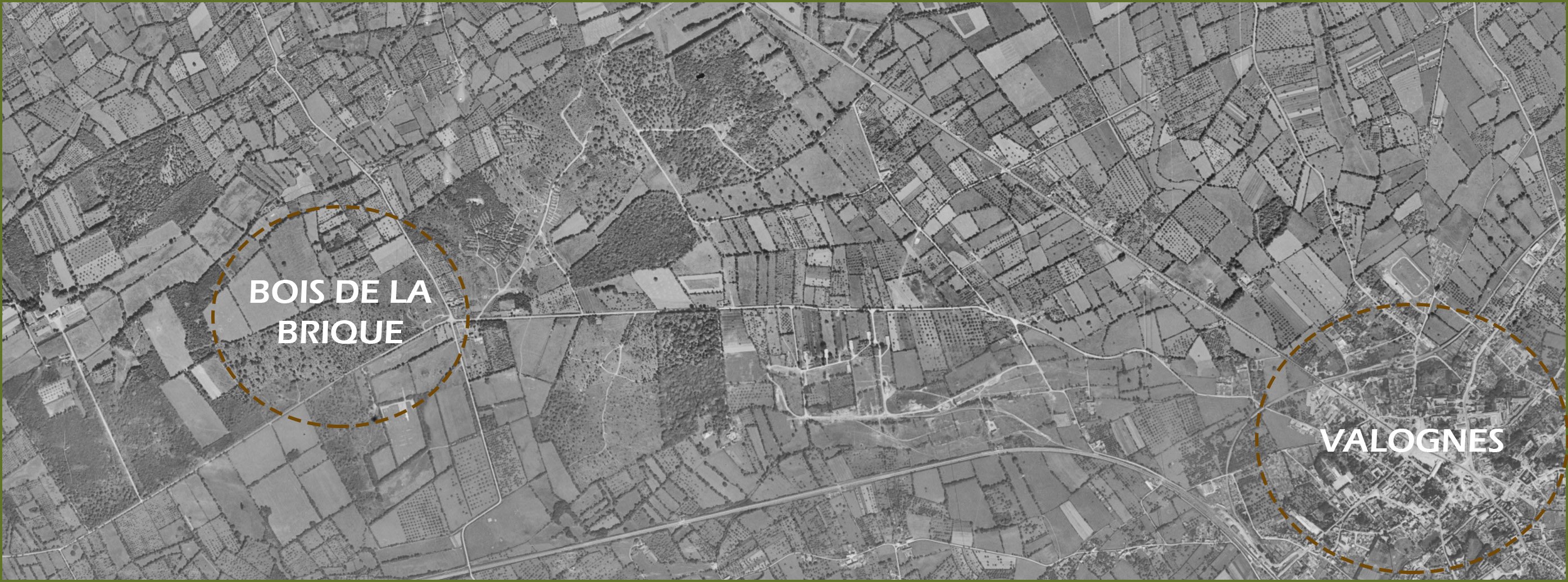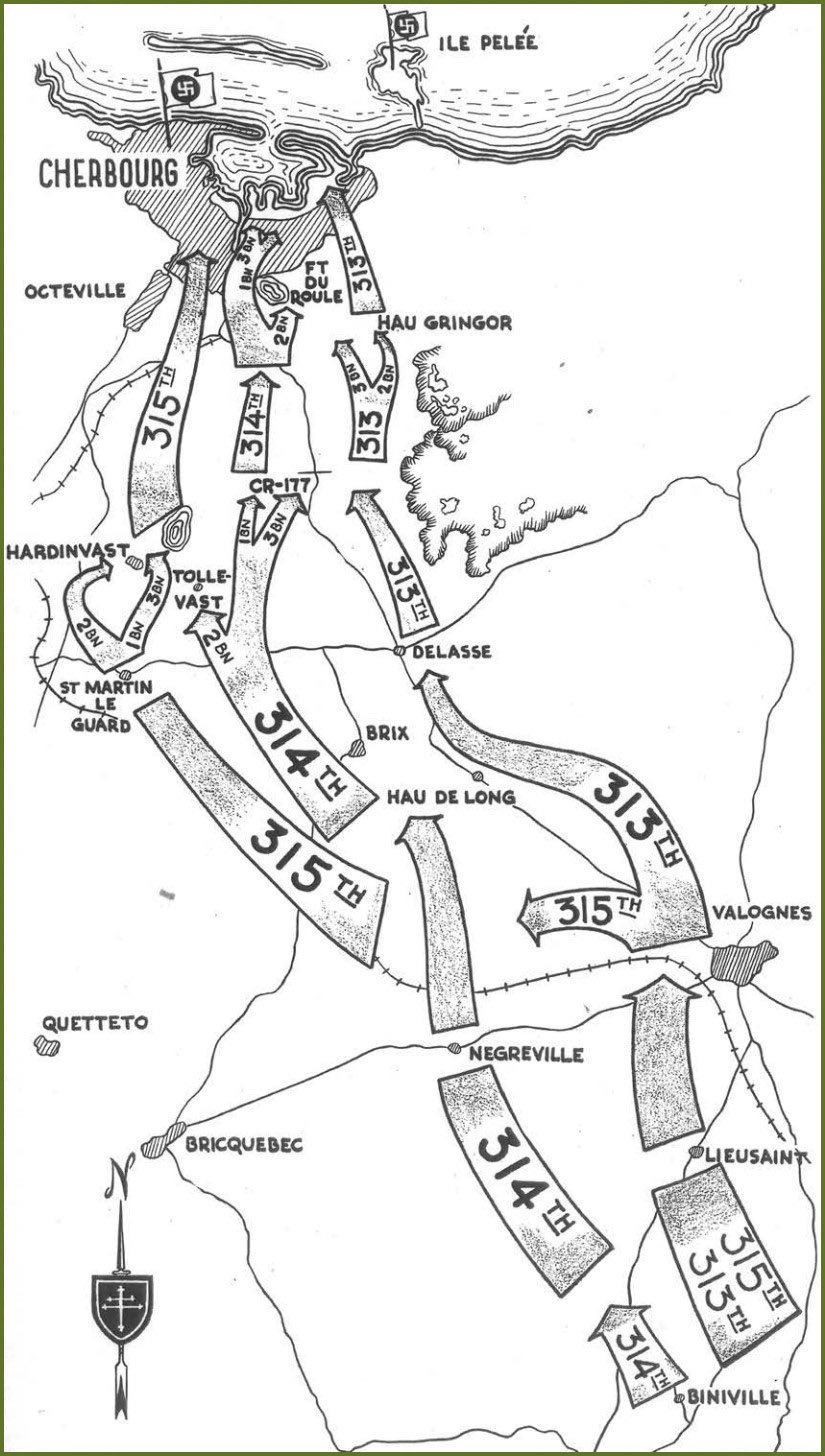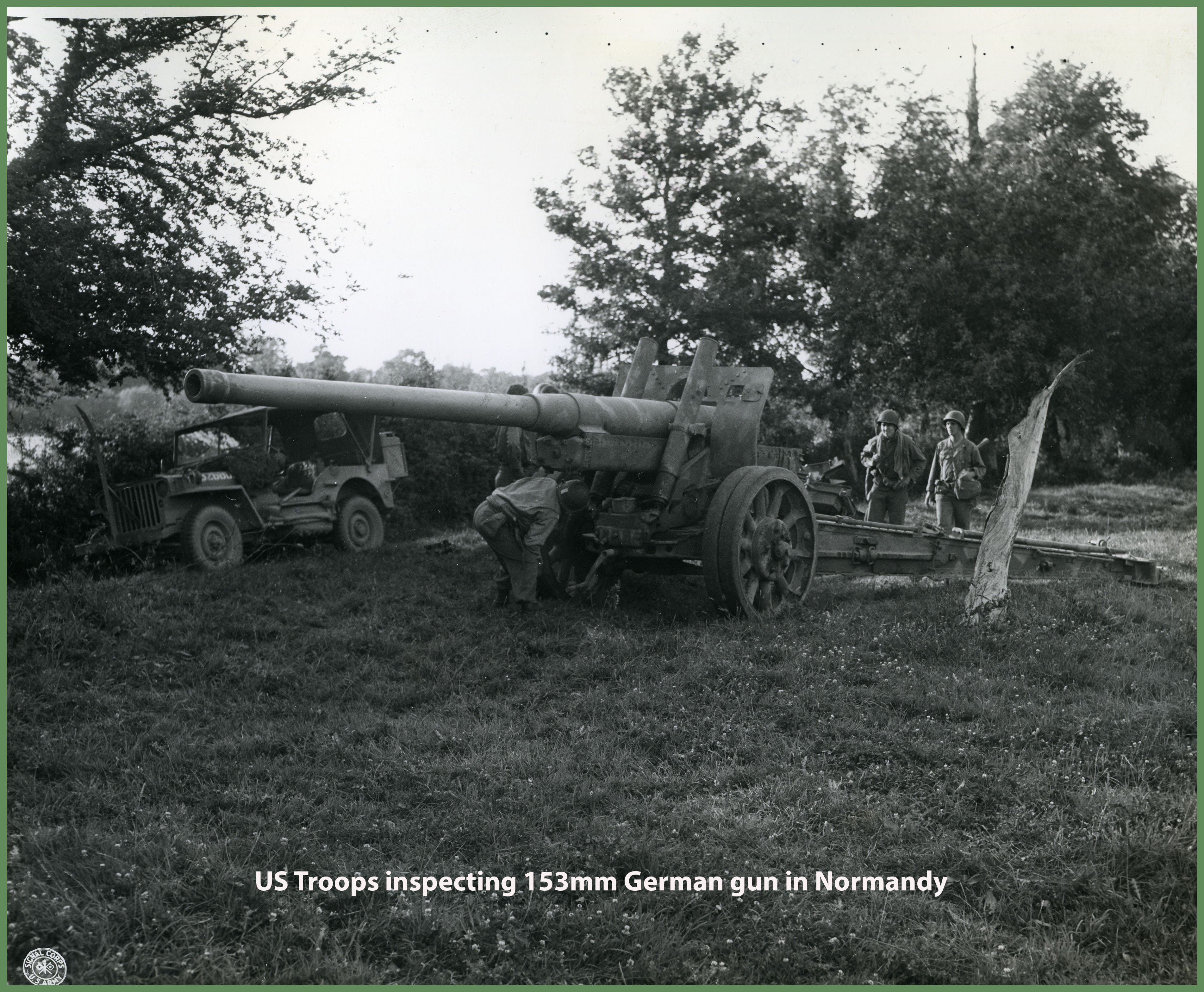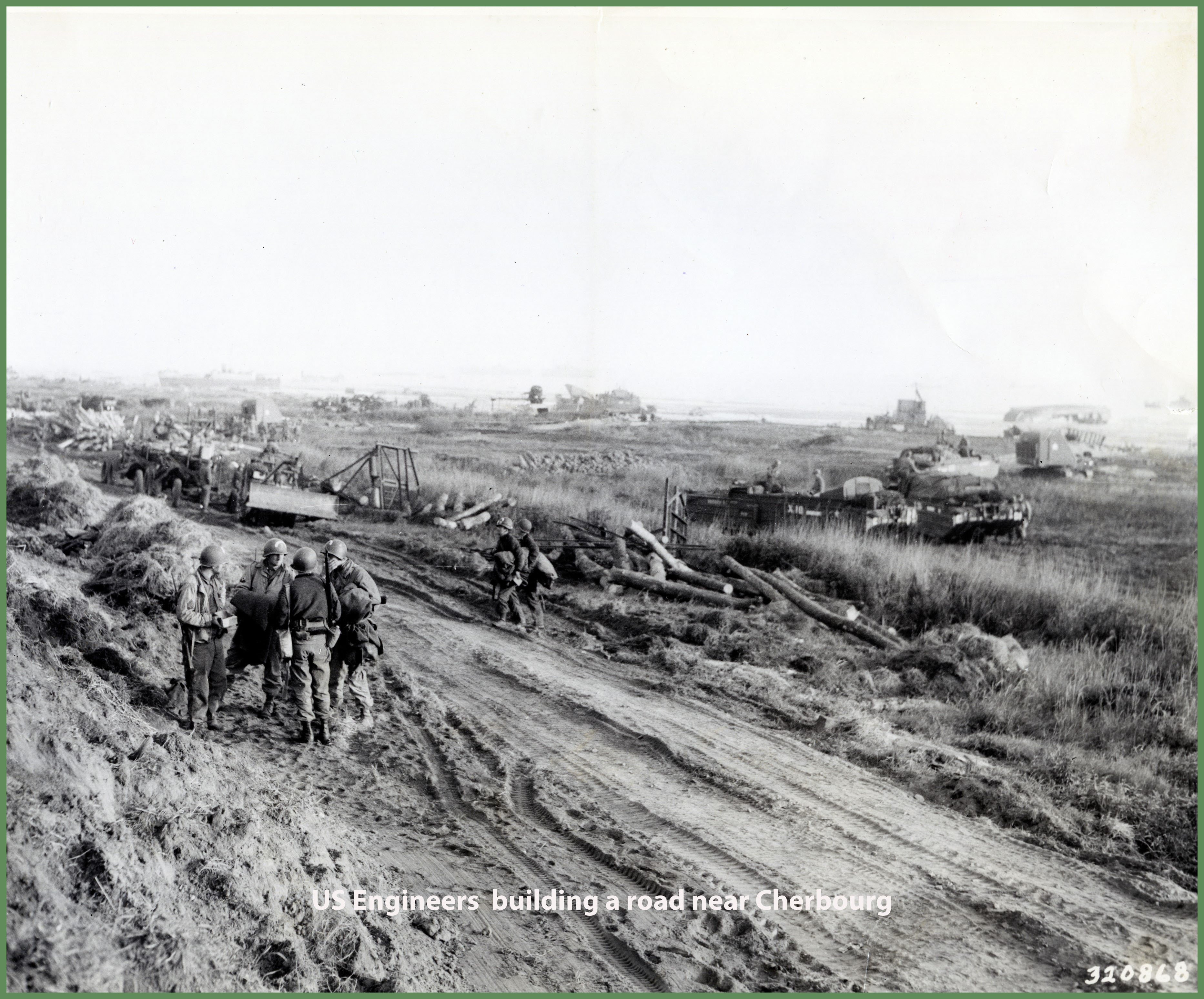Arrival in France
The 79th Infantry Division came ashore on June 14th,1944, at 0400pm and was the fourth American Infantry Division to land on Utah Beach.
The first man ashore was 2nd Lieutenant Lynn K. Copp of the Regimental Headquarters Company. Once every man of the 313th Infantry Regiment were disembarked from the LCT, they all started to march to their assembly area to Sébeville, a distance approximately 15 miles where the motor elements joined them.
Troops of the 79th landed at Utah Beach - ©CombatReels.com
The Regiment remained in its assembly area until the 16th of June while the rest of the division was landing. They then moved to the vicinity of Picauville at Pont l’Abbé (D-70) in the VII Corps Reserve.
Objective Cherbourg
On the 19th of June, the 313th Infantry Regiment was ordered to relieved the 359th Infantry Regiment of the 90th Infantry Division near Sainte-Colombe, with the attached units:
- “A” Company of the 304th Medical Battalion
- “A” Company of the 304th Engineer Battalion
- “A” Company of the 746th Tank Battalion
- “A” Company of the 82nd Chemical Mortar Battalion.
The attack jumped off exactly at 0500am from the vicinity of Golleville – Biniville with the 1st and 3rd Battalions in the lead (1st on the left and 3rd on the right. 2nd was in reserve), the objective was the high ground in the vicinity of Bois de la Brique (see map below) located at 2,48 miles west of the city of Valognes. Only the 1st Battalion reached the objective where it was joined by “A” Company of the 746th Tank Battalion around 0200pm, then started to dig in defensive positions should the Germans decide to counterattack. The 3rd Battalion was held up by a heavy German resistance at 0,62 mile of its objective.
 ©2023IGNMap
©2023IGNMap
Around 0600pm, the Division Headquarters decided to use the 2nd Battalion which was still in reserve to support the attack of the 315th Infantry Regiment. Other directives were received to change the direction of the attack. The new plan was now along the boundary between the 313th and 315th Infantry Regiments to the southern slope of Hill 79. The three battalions of the 313th Infantry Regiment remained in Bois de la Brique during the night of the 19th to the 20th of June. In the early hours of the 20th , the attack was resumed but the Germans destroyed a bridge about 1 miles north of Bois de la Brique delaying the advance of the motor elements.
The elements of the 313th Infantry Regiment passed by Valognes – Cherbourg highway at the northwest of the village of Saint Joseph, then followed the road onto Cherbourg. Passing through the village of Saint-Thomas, the 2nd Battalion received enemy artillery fire and machine gun fire. Men decided to deploy to attack the German positions as the enemy fire was too heavy. The advance was again held up near the crossroads coded 150. The regiment came under artillery fire coming from fortified positions at the crossroad coded 148.
Patrols were sent to determine the German strength on the night of the 20th to the 21st, during all the day of the 21st and during the night of the 21st to the 22nd of June 1944.
On June 22nd, the regiment resumed its attack on the German fortified positions which had held them for now two long days. At 0200pm elements were withdrawn 1000 yards south so the bombers could drop their bombs safely without causing friendly fire. The plan of attack was as follows: 1st Battalion in lead, followed by the 3rd Battalion and the 2nd Battalion in the rear.
The attack was triggered, the three battalions were under enemy fire, the 1st Battalion was stopped by German pillboxes, the 3rd Battalion was moving on the right of the 2nd Battalion. The 2nd Battalion overcame the enemy resistance and came to the rescue of their band of brothers by passing through the rear of the pillboxes which were holding up the 1st Battalion. The need to reorganize soon arose as the 3rd Battalion was headed east and the 1st Battalion north!
Once battalions reorganized, the 1st Battalion took position on the right of the road Cherbourg – Valognes followed by the 2nd Battalion and the 3rd Battalion on the left. The attack was then resumed: men of the 2nd found themselves in the middle of the enemy resistance but the smell of the blood, of the smoke and the noise of the bullets plus the wooded area all around stunned them, and men got lost becoming confused. Only 69 soldiers of the 2nd Battalion were still able to continue the attack. The 313th Infantry Regiment continued its advance toward Cherbourg meeting only light resistance.
 Advance of the 79th Infantry Division from Utah to Cherbourg - ©79thUnitHistory
Advance of the 79th Infantry Division from Utah to Cherbourg - ©79thUnitHistory
The Germans didn’t know that the 313th Infantry Regiment was bivouacking there. The German traffic continued on the road next to them!
In the early hours of the 23rd of June, it was discovered that the Germans had cut the lines of communications between the 313th, 314th and 315th Infantry Regiments and the only contact that the 313th Infantry had with friendly troops was with the 1st Battalion of the 314th Infantry Regiment.
On that day the 313th Infantry was given the mission to continue its attack on the remaining German strongpoints before the Fortress of Cherbourg. This attack was scheduled as follows:
- From 0900am to 0905am a dive-bombing attack would take place on the German positions followed by artillery fire until 0930am.
- The 1st, 2nd and 3rd Battalions will move in column on battalion under the artillery fire as near as possible to the enemy positions and will jump off once artillery fire is over.
As scheduled the three battalions of the 313th Infantry Regiment went into action reducing their first objective at 1000 yards in the north, but the German artillery decided to answer by firing back, forcing the troops to stop. While the men were forced to stop, additional information was received through artillery channels at 1045am.
The attack was postponed until 1130 hours but why? An air bombardment was going to take place at 1100am before the assault! As it was impossible to cancel the air attack (bombers were already in the area), the objective was bombed while the men of the 313th Infantry Regiment were on it. Men had to retreat while the friendly bombs were falling all around them. Worse, the Germans decided to increase their artillery fire. All hell was let loose!
On the 24th of June, the attack was again resumed in the same maneuver as the previous day in column of battalions: 2nd Battalion in lead, 1st Battalion in the middle and the 3rd Battalion at the rear to envelope the Germans from the right flank. This maneuver was successful, the enemy soldiers started to abandon their position giving the opportunity to American troops to push toward the high ground of Hameau Gringore (near N-13 - see map above)
When the American troops entered the hamlet, three 155mm guns and two 170mm guns with several other artillery guns were found. Around 320 prisoners of war were taken in Hameau Gringore.

The enemy had not expected this attack. Why? When the 313th Infantry Regiment reduced the artillery position near Hameau Gringore, numerous prisoners of war were taken but large kettles were found inside the kitchen of the enemy fortifications. They were full of beef stew and most of enemy troops were assembled probably getting ready to eat.
Beginning of the end
The morning of the 25th of June was spent in patrolling and mopping up, the regiment moved from the high ground North of Hameau Gringore to a position just South of Cherbourg (crossroad coded 177 - see map above) at 0200pm.
The advance was still made in column of battalions with the 2nd Battalion leading the column, followed by the 1st Battalion and the 3rd Battalion in the rear. Upon reaching the first houses of Cherbourg, four officer combat patrols were sent to penetrate the outskirts of the city, meeting some German opposition and taking many prisoners of war. While the rest of the 313th Infantry Regiment was waiting for the combat patrols, a German battery located in the face of the cliff below the Fort du Roule opened fire and shelled the regiment.
Note: Normandy American Heroes guests have the privilege to visit the underground tunnels of Fort du Roule!
On the final day of the German occupation in Cherbourg, June, 26th, 1944, the 313th Infantry Regiment attacked its final objective, the city itself and succeeded in reaching its objective, the beach at 0800am.
Men of the 313th Infantry Regiment fighting in the streets of Cherbourg - ©CombatReels.com
Considerable sporadic resistance was met while passing through the streets, “A” Company of the 746th Tank Battalion provided a fire support that the infantrymen couldn’t neglect. The main opposition came from the guns below the Fort du Roule and from "Dock of Normandy" where the 1st Battalion encountered heavy resistance. The 1st Battalion was held up by four concrete pillboxes for some hours, only mortar fire, antitank guns, and two platoons of “A” Company of the 746th Tank Battalion which fired with their 75mm guns forced the remaining Germans to surrender.
At 0630pm, 57mm antitank guns were directed against the German guns on the cliff below Fort du Roule. Only fifteen minutes were enough to silence those guns. Men of the regiment captured 1128 prisoners of war on this day.
The 87th Chemical Mortar Battalion attached to the 79th Infantry Division gave/received an effective support during the Cherbourg Campaign while the men of "A" Company of the 304th Engineer Battalion built bridges across the many streams in the Cotentin Peninsula. "A" Company of the 304th Medical Battalion was very effective in the wounded and men killed in action.
Last but not least, the fire from the guns of the 310th Field Artillery Battalion gave a support and allowed to overcome the German artillery.

From June 19th to June 26th, the 313th Infantry Regiment altogether captured 2240 prisoners of war.
Cherbourg Campaign came with a price! To seize the first objective of the liberation of France and Europe, the 313th Infantry Regiment suffered 845 casualties.
6 officers and 122 enlisted en were Killed in Action, 29 officers and 533 enlisted men were Wounded in Action, 1 officer and 122 enlisted men were Missing in Action and 32 enlisted men were suffering of Combat Stress Reaction.
Written by Pierre Fallet, Normandy American Heroes.

















